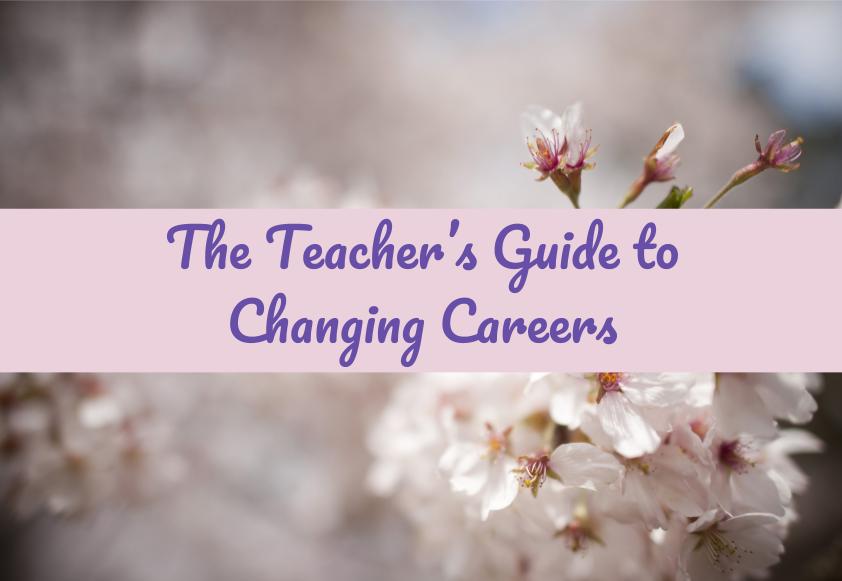
At the end of Dan’s last article, “I Quit Teaching and Won’t Go Back,” he wrote:
This article, the third and final part in this series, is Dan’s advice.

Dan Laird
Since I was employed by the same district where I completed my internship, I never really experienced the whole job search process. I earned my place, but I certainly was lucky to be interning in a school with an opening. I now found myself looking for a job with no experience looking for a job. Obviously, I knew the basics, but I was now swimming in unfamiliar waters, waters that had expanded thanks to the internet.
Step 1: Update the Ol’ Resumé
Since the last entry on my most recent résumé from 1999 was for being a delivery driver for Pizza Hut, I had some work to do. And since that résumé was stored on a 5 ¼” floppy disk, I found it best to simply start over rather than see if the Smithsonian offered computer time. Because I was keeping my options open, I realized that I would be tweaking my résumé and cover letter again and again to match the job for which I was applying. After all, I highly doubt that the folks hiring for the copywriting position I pursued were interested in my proficiency with Google Classroom. To handle the task of juggling multiple résumés, I paid for a monthly subscription to the résumé building site, MyPerfectRésumé. It allowed me to save multiple drafts and focus on the content without the hassle of the formatting. (Helpful hint: I also discovered that if you pay for a month or two then attempt to cancel, the site will offer you a full year for the price of one month.)
Every time I applied for a job, I made a folder on my computer for that application, résumé, and cover letter. In the modern tech age, it is easy to apply for jobs at a rapid-fire pace. Despite that, some companies will respond as if it is the only job you pursued, and, believe it or not, their initial correspondence may offer very little indication as to which job posting they are referring. If you are casting a wide net, it can be very easy to lose track of your applications and nothing is more of a turn off for potential employers than confusing one opening for another. Also, by keeping a file for each application, I could easily find the closest résumé version for adaptation that best fit the next job posting.
Step 2: Finally Learn About LinkedIn
Despite being the butt of jokes for years, LinkedIn proved to have a place in the job search world. It turns out that employers may want to do their homework on you and this gives them a social media source to learn more about your professional accomplishments without having to sort through New Year’s Eve photos, your angry comments about being a cursed Detroit Lions fan, or hilarious cat memes. (Sidenote: You might want to check the privacy settings on your Facebook account). Since I was determined to go all out on this venture, I paid for the premium subscription during my job hunt which allowed me to see who was reviewing my profile. I was pleasantly surprised to find views from companies to which I was applying.
In addition, many job search sites allow you to attach your LinkedIn profile to applications. Some even convert your LinkedIn profile information into the application itself. Since the résumé needs to be short, sweet, and right to the point, the LinkedIn profile allows you to really draw attention to work you want to emphasize.
Step 3: Find Your Source for Jobs
Job search sites seem like a dime a dozen. It’s important that you do your homework and monitor your success rate so you know what works best for you. Check to see if the site allows you to apply on its page or if it redirects you to other sites. Remember that companies pay to post their jobs on these sites. If the site you picked isn’t taking the application directly, it probably isn’t being used by the company who posted the job, which means your application may be dead in the water and lost to the internet.
Most of my success came from Indeed.com. In fact, that is where I found my current job. Indeed provides a very quick application process. If you have your résumé and cover letter ready to go, you can send it with the click of a button. A nice way to tell if a company has invested its money with Indeed is to see if it has added on to the application process. Companies can use a default application or they can add their own questions to the process. If you see these extra questions, you know that the company has prioritized this hiring source in its budget. If you do see short response questions on an application, always save your responses in a separate document so you don’t lose them once you submit your application. If you apply for another similar position, you may find a similar question.
Step 4: Cast a Wide Net
One of the biggest misconceptions teachers have is that their qualifications lock them into a teaching role for life. It’s certainly what I thought. What else can you do with a history major and English minor? Curate a museum? Write the great American novel? Finding an open position with the former is about as likely as becoming a rock star and the latter isn’t exactly a financially sound decision for a 40-year-old with two children and a mortgage.
I learned to stop searching for jobs for which I thought I was qualified and instead to start searching for my qualifications. First, I searched for ALL jobs in my city and state. For years I had been telling my students that they may very well end up in jobs that haven’t been invented yet. Here was my chance to see what had been invented since I joined the workforce. Of course, there were jobs that sounded great for which I was nowhere near qualified. Still, those are options if you have a long-term plan that involves going back to school. So if you want out and can bear it a few more years, target one of these jobs and start taking classes now. But there were also opportunities for people like me looking to make an immediate evacuation. From there, I started looking for more jobs like the ones I stumbled upon. It was a domino effect of discovery. As it turns out, the world needs teachers in every corner of the workforce and not just for teaching STEAM.
Step 5: Don’t Wait. Keep Applying.
Just because a position is posted, it doesn’t mean that anyone is in any hurry to fill that position. Nothing proves this point more than positions for the state. When you check your state government website for job postings, you will most likely find more postings than you have time to look through. After applying for a few state positions, I started to get the feeling that even the state didn’t want to look through all of them. Rarely did I ever hear back from one of these applications. A few times I was told a position was filled. Once I was told that the state changed its mind and eliminated the position. Most of the time, I heard nothing. The downside to fast and furious job application technology is that most companies now have to sort through applications from people who only applied because they had nothing to lose.
Step 6: Know What You’re Getting Yourself Into
It’s a very exciting feeling to get called for an interview. While the interview is a great chance for the employer to get to know you, remember that it is also a good opportunity to learn more about the job for which you applied, sometimes without even asking a single question.
Not all job postings are specific. They may give you enough information to pique your interest, and hold back information that may cause you to look elsewhere. In addition, some job sites allow you to leave your résumé posted on a general “bulletin board” for any employer to see. This may lead to calls for interviews you didn’t expect, especially from insurance companies. Because I was keeping my options open, I attended some of these. A few of these interviews were located in bare offices that looked like they had been rented for the day. One interviewer mistakenly thought, ¨How would you like to live in Indiana?” was an enticing sales pitch. And one scheduled interview turned out to be a group interview with a dozen other candidates. This wasn’t necessarily a bad thing, but when asked what we were all looking for from this position, one applicant responded, “I want time to do my karate.” No offense to the karate kid, but I felt like I had a bit more to offer and was surprised we were up for the same position. It was clear that I was not invited there for my extensive résumé. Lower level employees were clearly mass-hired, disposable commodities.
Don’t be embarrassed about getting tricked by these “opportunities.” This process took me almost a year to get the hang of. As long as you’re not sacrificing something more important, you have nothing to lose by going to these interviews. Use the opportunity to brush up on your interview skills, learn to anticipate some typical questions, and, at the very least, give yourself an interesting story to tell. You never know when something might surprise you. In fact, before I took my current job, I was in the process of accepting a position with a financial company that happened to specialize in teacher 403b retirement funds. It was an unanticipated natural fit and the company was excited to have an actual former teacher on the team. I would probably be working there if my current job hadn’t made an offer right before I was to take my exams.
So, to recap:
- You have value outside of the classroom.
- Your qualifications do not lock you into a teaching job for life.
- Learn about expectations for résumés outside of education. They’re different. Then update your résumé. I recommend subscribing to a résumé building website.
- Set up or update your Linkedin account. Learn about best practices that will help attract interest from employers.
- Investigate different job search sites and determine which works best for you.
- Search for all jobs in your geographical area. You’ll learn about jobs you didn’t know existed. The discovery process will help you figure out which jobs fit your qualifications.
- Don’t wait to hear back because many times you won’t. Just keep applying.
- Keep your options open. Attend interviews. You’ll become more comfortable with them, become better prepared to answer common questions, and learn what companies are looking for.
- Be patient but persistent. Keep looking, applying, and interviewing.
- Forgive yourself. I made lots of mistakes, but this was a new experience. Recognize that it’s going to take you a while to get the hang of it.
Good luck!
Thanks for reading the series! Dan and I both appreciate your interest and we hope this has helped those of you thinking of making a change. For those who plan on persisting in the classroom for the next five or ten or fifteen years, I have a book called Leave School At School that will help you cut back on hours without sacrificing your impact with kids. In fact, because you’ll be more focused, better-rested, and less stressed, you’ll probably be a better teacher.
No comments:
Post a Comment